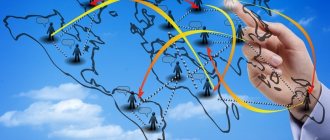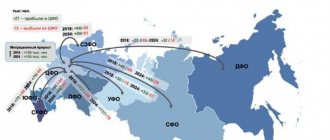What is migration?
Migration refers to the movement of citizens of a country within its borders or abroad. Internal migrations are divided into groups depending on the timing (temporary, seasonal) and purpose (work, tourism) of the move. Separately, the pendulum type is taken into account, when residents make constant trips to work, study, or treatment in another locality.
Citizens crossing the state border are classified as emigrants (leaving the country) or immigrants (entering the country).
The general name for this category of citizens is migrants. In Russia, the Federal Migration Service (FMS) deals with immigrants.
Rice. 1. Employees of the Federal Migration Service of Russia.
Episodic migrations
There are four main types of spatial population movement that determine migration growth.
Episodic migrations periodically affect the number of inhabitants. Thanks to them, at one moment the number of residents in a locality can become many times greater. These are, as a rule, trips related to recreation and tourism, business and others. They have no time frame or set direction. The individuals involved in this type of spatial movement can be quite different. If these are business trips, then, of course, able-bodied citizens travel. But when it comes to recreation, the contingent becomes wider.
Since episodic migration growth is difficult to explain and is only temporary, it is practically not studied. Although this is despite the fact that this type of spatial movement is the most large-scale, especially in the field of tourism.
What is migration growth?
Migration growth is the difference between those who came to a region and those who left. When a negative number is obtained, they speak of migration loss.
In Russia, to determine migration growth, only persons who have received the right to permanent residence (permanent residence) or who left the country with the intention of obtaining such an opportunity in another country are taken into account. This is an irreversible type of population migration.
Rice. 2. Migration growth in Russia, graph.
Seasonal migrations
This category includes people who, for some reason, were forced to leave their permanent place of residence for an indefinite period. Thanks to this type of movement, the labor shortage is filled and production needs are satisfied. The reason for this process is the uneven distribution of economic levels in the regions. The latter is due to the fact that certain industries generate more income. That is, in such places there is always a need for workers. If local resources cannot replenish it, then additional ones are attracted from other regions.
Most often, this movement is caused by seasonal industries. This is agriculture (mainly sowing and harvesting), logging and coastal fishing.
Calculation of migration growth
For calculations, there is a formula for migration growth: MP = P - V (persons), where MP means the amount of migration growth, P is the number of arrivals, V is the number of departures.
Migration growth is depicted in the form of graphs, diagrams, and tables.
Rice. 3. Migration growth in Russia, diagram.
Permanent migration
Most of all, the magnitude of migration growth depends on this type of population movement. Researchers define it as irrevocable movement, that is, a complete change of place of residence. In order to characterize the process as permanent migration, two points must be met:
- the first is a change of place of residence to another locality, which immediately cuts off travel within a city or village;
- the second is irrevocability, which is the main condition, excluding temporary or short-term trips.
Problem solving
Let's try to solve 2 types of problems.
- How to find the migration increase from the table?
| Types of migration | Number of arrivals, people | Number of people leaving, people |
| Migration within the country | 1 940 000 | 1 940 000 |
| Within regions | 1 750 000 | 1 750 000 |
| Between regions | 190 000 | 190 000 |
| International (for permanent residence) | 26 000 | 15 000 |
To determine migration growth, only international migration needs to be counted. We use the formula: MP = P – B = 26,000 – 15,000 = 11,000 people.
- How to determine population growth in a region for a particular year?
Data: number of arrivals for permanent residence = 40,000 people; number of people leaving for permanent residence = 10,000 people; natural increase (NU) people/year = 3500 people.
We act in 2 stages:
MP = P – V = 40,000 – 10,000 = 30,000 (persons)
Total increase = MP + EP = 30,000 + 3500 = 33,500 (persons)
When receiving negative values, the sign must be taken into account when calculating, as in a regular mathematical operation.
Migration rates
Statistics are the main source of information about the qualitative and quantitative indicators of migration processes.
Statistics include a periodic population census, records of arrivals and departures, and illuminates the motives for the resettlement of citizens. Migration processes can be quantified using a system of migration indicators.
Note 1
Migration indicators describe the general level of population mobility, the direction, scale and success of migration processes over a certain period of time.
The system of migration indicators (per 1000 people) consists of absolute and relative indicators. With their help, one can judge the volume, intensity, effectiveness, directions of migration flows and other factors. The balance of general and labor migration allows us to show labor flows.
Help with student work on the topic Migration Indicators
Coursework 460 ₽ Essay 270 ₽ Test paper 210 ₽
Get completed work or consultation with a specialist on your educational project Find out the cost
Absolute and relative indicators are calculated for individual population groups (men, women, ethnicity, urban or rural residents) and for the entire population.
The system of statistical indicators of international migration includes the following criteria:
- general features characterizing migration processes common to a given territory;
- special ones, showing the relocation of certain social and demographic groups;
- indicators of interdistrict exchange.
To analyze the survival rate - the final stage of migration - indicators of the mobility of moving citizens, the ratio of local residents and migrants, and the average number of years that settled citizens lived in a given territory are used.
Balance of migration in Russia
17.07.2019
Does the number of emigrants and migrants influence the situation in the country? Answer: yes, and very significant.
That is why statistical departments carry out regular calculations, establishing the situation in a country or a given region, to determine the migration rate.
This article will discuss the concept of migration balance, what its purpose is, what impact it has in general and how to calculate it.
What is migration balance
This term refers to an indicator that is used to calculate statistical data.
According to general rules, this term is usually used to denote the number of citizens of other states who arrived in the state (migrants) and the number of those who left it (emigrants) during a specified period of time.
The indicator is usually referred to as absolute, directly related to the total number of people living in a particular region of the country.
Federal Law of July 18, 2006 No. 109-FZ “On Migration Registration”
Volumes of population migration in 2005-2017
Positive value
If the indicator becomes positive, this indicates that the number of immigrants arriving in the country exceeds the number of emigrants. Such indicators are more common in large, rich countries that can provide a sufficient number of jobs for visitors and citizens living in the territory.
What does a negative value mean?
A negative value indicates a decrease in the population in the country as a whole. What matters is not only mortality and fertility, but the number of citizens who left the state. The reasons for population decline can be different: environmental disasters, natural disasters, the socio-economic situation in the country. Unemployment is no less important.
Typology of Russian regions by components of overall population growth (decrease) in 2007
Established Concepts
To understand the process of calculating an indicator, knowledge of basic concepts is required:
- migration is a process in which the population of one country moves beyond its borders for permanent residence in another territory;
- migration balance is an indicator that describes the difference between arriving and departing citizens on the territory of one state in a certain period of time. The calculation can be carried out for a quarter, six months, a year or several years;
- labor migration is a type of relocation to another territory for the purpose of working;
- GDP (gross domestic product) is a factor indicating the cost of goods and services in the market of a particular state in a specified period of time.
Types of values
Absolute migration indicators include the following values:
- the number of citizens arriving in the territory (region, locality). Designated as "P";
- the number of people who left the point - “B”;
- balance or net “MS” or “N”;
- volume (gross or turnover) - “MO”.
Read also: Refund of personal income tax on a patent to a foreign worker
The volume indicator is not a type of migration, like the balance. This indicator is calculated based on the sum of the number of arrivals and departures in a certain region over a period of time.
The migration balance itself is usually divided into:
- external - displaying the difference between those who arrived and left a specific region;
- internal - shows movement throughout the country;
- different population groups - depending on nationality. Balance of migration in 2013
What is mechanical gain and how is it calculated
As already mentioned, the migration balance is an indicator of the difference between citizens who arrived and left the country. A simple formula is used for the calculation - “MS” equals “P” minus “B”.
Volume of migration
To calculate the volume, you will need to use data on citizens who arrived and left a certain territory during a specified period of time. The calculation is as follows: “MO” is equal to “P” plus “B”.
The indicated indicators are specific numbers that are influenced by the indicators of a certain territory. As a rule, the meanings themselves cannot describe the entire situation as a whole. It is for this reason that an additional indicator such as the migration rate is used.
What classifications exist
The migration balance allows you to determine the rate of mechanical growth. However, when making calculations, additional nuances should be taken into account. The classification indicator is of great importance.
However, even in this case it is impossible to avoid certain errors. It is for this reason that the classification of indicators is usually divided into absolute and relative.
These values help make more accurate calculations. However, even these should be treated with a small amount of skepticism, with the addition and subtraction of a certain proportion of the number.
Absolute
The absolute category of classification usually includes:
- the total number of persons arriving in the country. The meaning is used both in relation to the entire state and in specific areas and settlements;
- the total number of citizens who left the specified territory for another state for permanent residence or work;
- migration balance - the difference between arrivals and departures;
- volume of migration.
Relative
The following values are usually included in this group:
- arrival rate - a formula is calculated to determine the number of immigrants per population of a thousand people. Formula: “P” is divided by “N” and multiplied by 1000;
- departure rate - denotes the total number of emigrants per 1000 population. It is calculated by the formula: “B” is divided by “H” and multiplied by 1000;
- migration turnover - calculated by adding the number of citizens arriving and leaving the country by a certain number of population. Formula: “P” is added to “B”, the result is divided by “N” and multiplied by 1000;
- balance - a number value for a certain amount of population living in the territory of the state. Calculation: “P” minus “B”, the result is divided by “N” and multiplied by 1000;
- migration efficiency - the indicator is calculated using the values of balance and migration turnover. Expressed as a percentage. Formula: “P” minus “B”, the result is divided by the sum of “P” and “B” and multiplied by 1000;
- relative - the ratio between the number of people arriving and leaving the country, expressed as a percentage. Formula: “P” is divided by “B” and multiplied by 100.
Read also: Fine for a migrant to a legal entity
The Basic Essence of Migration and Growth
Migration - or change of place of permanent residence. Migration itself is one of the key concepts of the demographic process. The migration process directly affects the population in the country as a whole, and in individual regions, affecting the economic situation.
Migration growth in demographics is an indicator of the difference between the number of citizens arriving and leaving the country. This process is characterized by the following features:
- size;
- shape;
- reason;
- character;
- time period;
- legal status.
How is growth calculated?
To make correct calculations of migration growth, several coefficients will be required:
- the total number of citizens arriving in a specific region, region or locality “P”;
- the total number of persons who left country (region) “B”;
- net or migration balance "MS". General migration growth in Russia
The formula for calculating migration growth is quite simple. It is necessary to subtract from the value “P” the value “B”. As in other cases, the final result can be either positive or negative, as well as zero.
Approximate calculations
To make the calculation, take the following values as an example. If at the beginning of the year the total population in the country was 9.7 million people. By the end of the year, this figure increased to 11.4 million. At the same time, the birth and death rates for this period were 39 and 17 ppm.
Under these conditions, the calculation of the main indicators will be carried out as follows:
- Initially, natural population growth is calculated. The mortality rate is removed from the birth rate. In the indicated case 39-17 the result is 22%;
- The next step is to calculate the difference between the population indicator at the beginning and at the end of the year. From 11.4 subtract 9.7 resulting in 1.7 million people.
- 22% is natural population growth. Calculated per one thousand population, that is, 22 people. Thus, for 1.7 million people the result will be at 1.7 * 22% - 37.4 thousand people.
- Finally, 37.4 thousand are subtracted from 1.7 million, resulting in 1,326,000, which is the value of the balance of migration for a time period of one year.
The presented example is as simplified as possible, without the use of additional coefficients and values.
Relative migration rates
Relative migration indicators reflect the intensity of migration processes and the effectiveness of migration.
Definition 1
Migration efficiency is the ratio of arriving and departing citizens, expressed by the number of departures per 100 or 1000 arrivals.
The indicator of demographic costs allows you to compare the results obtained with the costs incurred, i.e. the number of migrants remaining in the settlement area with the number of arrivals. Reflects the material costs associated with the formation of a certain population in populated areas. The larger the positive balance of migration and the smaller the number of arrivals, the more efficient the migration process is.
The most often used are coefficients of intensity of migration processes, which make it possible to compare the migration mobility of the population of different regions. Expressed in ppm or percentage. These include:
- arrival rate – shows the ratio of the number of arrivals to the average population;
- departure rate - shows the ratio of the number of departures to the average population;
- migration growth coefficient - shows the ratio of the absolute indicator of migration growth to the average annual population;
- migration turnover coefficient - shows the ratio of migration turnover to the average population;
- migration balance coefficient - shows the ratio of the migration balance to the average population;
- efficiency coefficient of migration turnover - shows the ratio of the migration balance to the migration turnover (in percent);
- relative migration balance - shows the ratio of the number of arrivals to departures (in percentage);
- survival rate is equal to the ratio of migration growth to gross migration for the year.
Particular characteristics are obtained after calculating indicators for individual population groups (by gender, age, nationality, etc.).
Relative intensity indices show what share individual population groups occupy in the total number of arrivals or departures.
Master class in geography
The task consists of two parts. To solve the first part of this task, you must use the formula for calculating ppm. T,e value of the natural increase indicator for 2009. – this is -10063 divided by the average annual population of 1313035, and multiplied by 1000 people! EP=-10063/1313035x1000=-0.7663. The assignment tells us to round this number. So the correct answer is -8
As the Earth moves around the Sun
there is a change in the seasons of the year and a change in the length of the day and the height of the Sun above the horizon throughout the year. The main reason is the tilt of the Earth's axis by 66.5 0 and, as a result, a change in the poles of illumination. It is necessary to remember several significant dates and their characteristics:
We recommend reading: Renting a Residential Premises in the Leningrad Region in 2020
Structural indicators of migration
Structural indicators of migration can be absolute or relative. Calculated for different structural elements of the migration flow.
General structural indicators of potential migration include: the share of potential migrants, the share of relevant contingents (by age, gender, nationality, marital status, education, profession, etc.).
Structural indicators are not widely used, since the relevant information is local in nature and the research methods used to obtain it are not identical. Therefore, the level of potential migration mobility of different territories is mainly assessed based on the results of the implementation of migration plans.
Structural indicators of migration flows include: territorial, age, gender, educational, national structures of migrant flows and migration growth, the structure of migrants and migration growth by citizenship and reasons for migration.
— — Do you need help creating a study plan? — Specify a topic and receive a response in 15 minutes — — — — — — get help — —









